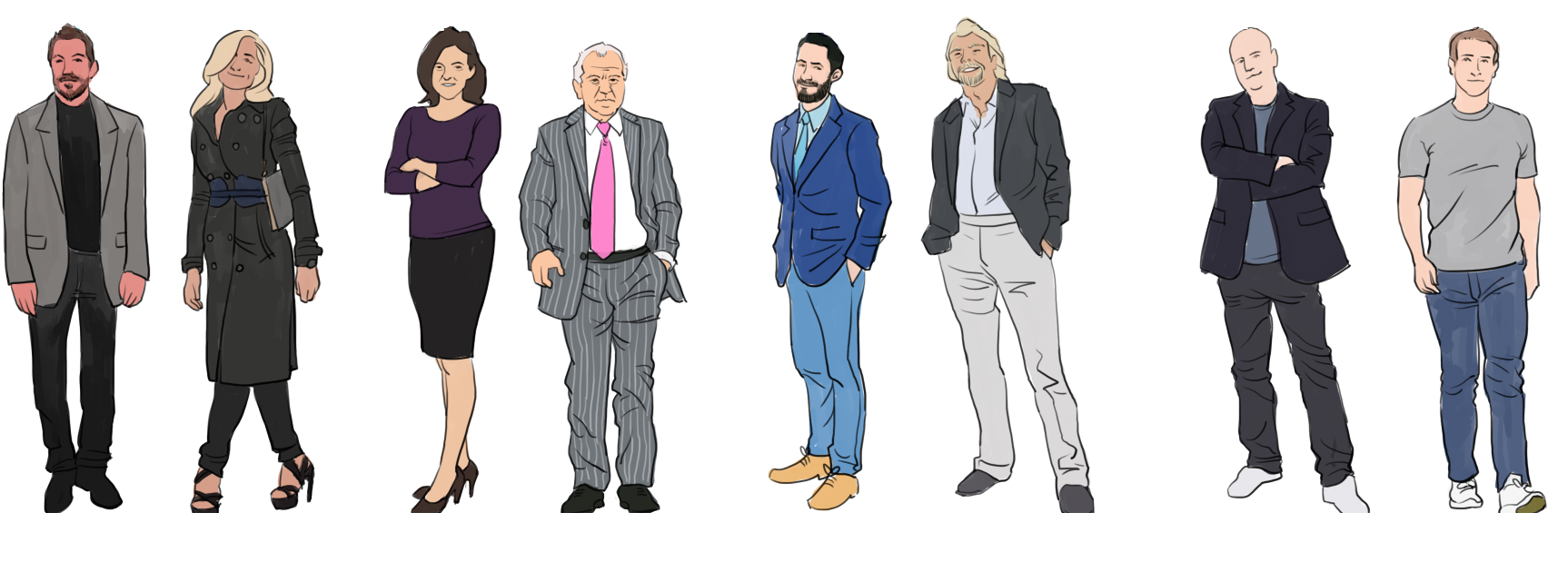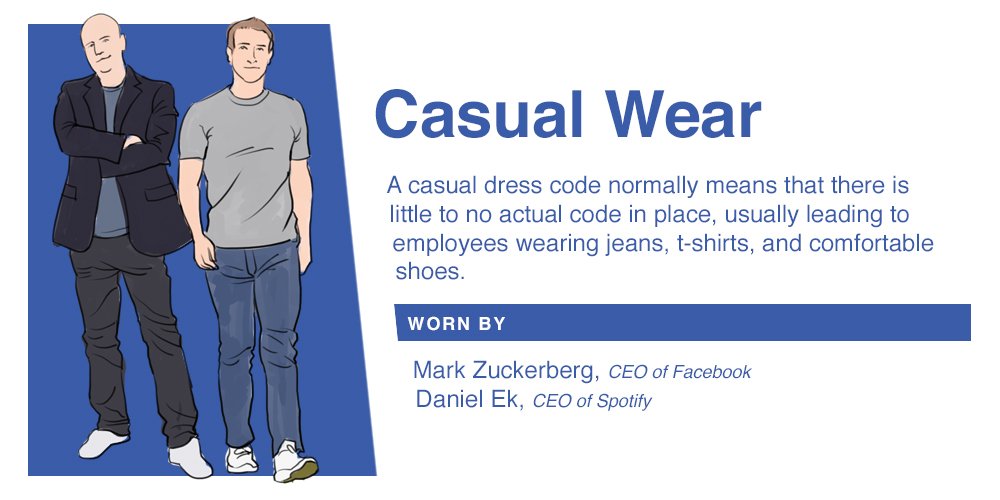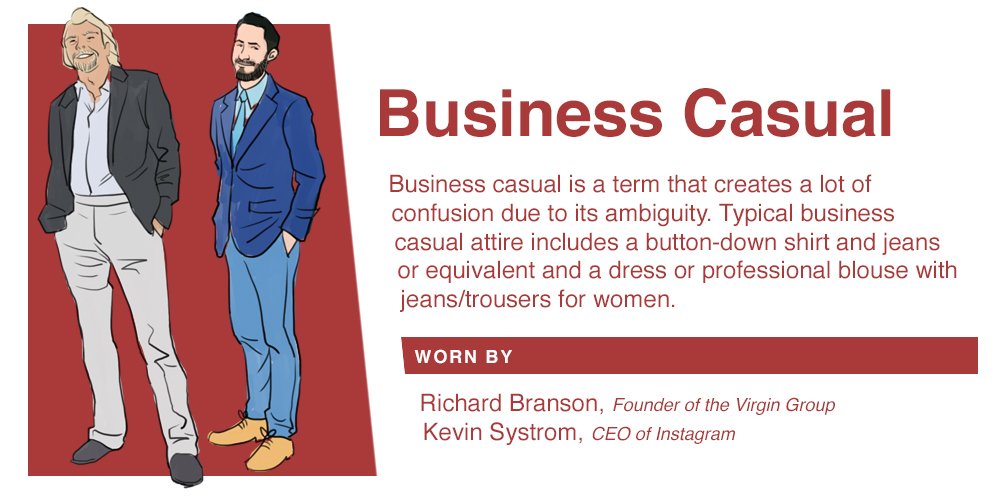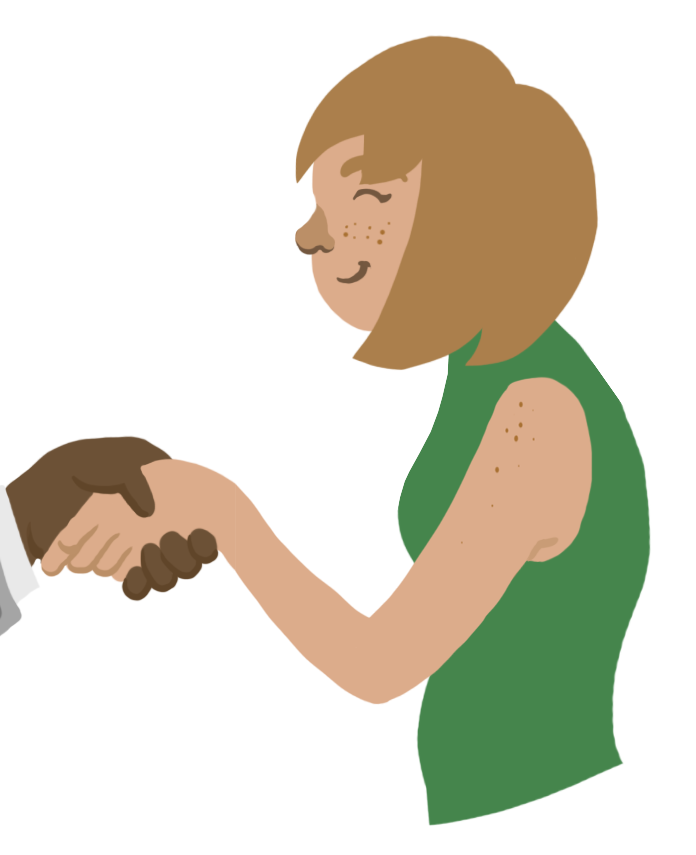A Guide To Workplace Dress Codes

The global fashion industry is worth $3,000,000,000,000 (3 trillion dollars), which is 2% of the world’s total GDP. We’re obsessed with clothes, and it shows in the workplace as much as anywhere!
Workplaces traditionally used dress codes (whether a uniform or just a set of clothing guidelines) to create a professional atmosphere and even the playing field for all employees. Over time though, the casual dress code has increased in popularity and raised the question – does it matter what we wear to work?
We’ve done some research into the differences between dress codes, whether they affect performance or how you’re seen in the workplace, and where they’re headed, with the help of an expert in the field; fashion psychologist Professor Carolyn Mair, founder of psychology.fashion and author of The Psychology of Fashion.
Table of Contents
Click a heading to go straight to that section.
1. Different Types of Dress Codes
– Casual wear
– Business Casual
– Business
– Designer clothing
2. Do Dress Codes Affect Job Performance?
3. What’s the Best Workplace Dress Code?
4. What Colour Should I Wear?
5. What’s the Most Popular Dress Code?
6. What’s the Future of Dress Codes?
Different Types of Dress Codes
We decided to split workplace dress codes into four distinct categories to make them easier to compare. They are casual, business casual, business, and designer.
Casual Wear

A casual dress code normally means that there is little to no actual code in place, which will usually lead to most employees wearing jeans, t-shirts, and running shoes. This is becoming more popular, with 53% of UK workers saying they no longer have a formal uniform.
But what effect does a casual dress code have on employees and managers?
Our expert, Professor Carolyn Mair, said the following:
On managers
“It depends very much on the type of business. In the creative industries this style of clothing is typical to enhance creativity without the restriction of formal clothing. Leaders and managers in the creative industries are likely to wear similar clothes to their subordinates which flattens out any organisational hierarchy.
If a manager in finance or insurance wore a t-shirt, jeans and running shoes, they would be considered inappropriately dressed, even maverick. Leaders in these industries are expected to lead by example and their staff are expected to follow rules. Dress down Fridays are an exception, but even on Fridays, most city workers wouldn’t wear a t-shirt, jeans, and running shoes.”
On employees
“Again this depends on the role and the nature of the organisation. In the City, this would definitely be a no-no. In a creative role it is practically the uniform. In other jobs where employees are free to wear what they choose (e.g., education), this style might still be considered too casual for work.”
World-renowned tech companies like Google, Apple, and Facebook are known for their super-casual dress codes, with employees regularly wearing jeans and t-shirts. The idea behind it seems to be that if employees feel comfortable, they can do their best work and can feel more accepted in the workplace.
A number of high profile business leaders such as Mark Zuckerberg of Facebook and Daniel Ek of Spotify are also famous for their casual clothing choices, with Mark Zuckerberg’s trademark grey t-shirt becoming a big part of his personal brand.
Business Casual

Business casual is the next step up in formality, and it’s a term that seems to create a lot of confusion. For this study into dress codes, we’re classing it as a button-down shirt and jeans or equivalent for men and a dress or professional blouse with jeans/trousers for women.
We asked Professor Mair what she thought about the effect business casual dress codes have on both managers and employees and she said:
“In an organisation where the management wears suits, a subordinate wearing business casual might seem less ambitious. If we are to believe the adage “dress for the job you want, not for the job you have”, we need to dress in a style similar to those in the job we aspire to.
We are drawn to people who are like us and what better way to appear like someone than to dress like them. Those already in the position we aspire to are likely to see us more as peers than subordinates if we appear to be like them.”
Business casual dress is very popular with the leaders of some of the biggest and most well-known companies in the world, with notable examples including Kevin Systrom of Instagram’s classic shirt, jeans, and jacket/jumper combination, Richard Branson’s dress shirt and suit pants (reflective of Virgin’s relaxed approach to dress), and Netflix’s Reed Hasting’s shirts with the top button open.
Business

Once the only dress code that mattered, business dress is now surprisingly rare with only one in ten people wearing a suit for work daily. Could this decline be influencing how we feel or are treated in the workplace? We asked Professor Mair:
On managers
“Some professionals in a range of jobs like to wear a suit and tie as it makes them feel more professional. Although there aren’t many studies on this, wearing a suit has been found to make the wearer appear more professional and competent. The power of belief is strong so if the wearer believes that the suit will make them appear more competent and professional, they may well behave in that way.”
On employees
“This would be seen as inappropriate in creative jobs, but necessary in others. In jobs where workers can choose what they wear, and managers dress casually, a subordinate wearing a suit and tie could be perceived as trying to look more senior than their role. There is also a risk that management might perceive them as not understanding the culture of the organisation or their role.”
The idea that the more senior you are, the more reason you have to wear a suit to appear competent, and that wearing a suit in a lower position can be seen as a bad thing creates an interesting contrast between managers and employees.
One of the best examples of a business leader who sticks to the business dress code is Alan Sugar, founder of Amstrad and host of the BBC show, The Apprentice. Alan Sugar is rarely seen out of a dark, well fitting suit, and the effect is that he’s generally seen as competent, business savvy, and professional.
Designer clothing

Not so much a dress code as a choice that depends a lot on personal wealth and the industry of employment, designer dress is the rarest of the four categories. Designer clothing is not often seen in the workplace, and when it is, it’s usually confined to those in managerial positions.
What does it say about us, and is it appropriate in all situations? We asked Professor Mair:
“A business manager/leader wearing a beautiful and well-fitting suit or appropriate fashion brand will give off an air of style and class which may set him or her apart from subordinates. This may be the reason for choosing to wear such clothes.
What we wear is part of our identity, it allows us to show who we are to others. Wearing luxury says we have spending power. In some situations (e.g., working in social services, for a charity or NGO) this could be considered insensitive, in others (e.g., the fashion industry), it would be considered exactly right.”
Unsurprisingly, the biggest examples of business leaders wearing designer clothing are from larger than life personalities heading up iconic stylish brands. Angela Ahrendts, the Senior Vice President of Retail at Apple, has gained coverage for wearing a $2985 Burberry coat at an Apple event while Luca di Montezemolo, the ex-head of Ferrari, was known for his bespoke designer suits and designer wristwatches.
Do Dress Codes Affect Job Performance?
So, can what you’re wearing in work actually affect how well you perform at your job? Aside from the practical nature of clothing – in that it should be suitable and not restrictive, limiting, or uncomfortable enough to distract you from your job – there may be something else to the impact clothes have on our performance based on the meaning we assign to them.
We asked our expert and she pointed our attention to a study completed in 2012, explaining its findings:
“In a 2012 study, two psychologists asked people to describe characteristics of a doctor. The most common characteristic was ‘attentive’. Having established this, the researchers conducted a series of studies and found that when participants were told they were wearing a doctor’s coat as opposed to a painter’s coat (the coat was an identical white lab coat in both cases) and completed an attention task, those who believed they were wearing the doctor’s coat outperformed those who believed they were wearing a painter’s coat.
The researchers concluded that there were two factors necessary for this to affect the participants: (i) the symbolic belief in the lab coat (that it belonged to a doctor) and (ii) actually wearing it.”
Source: https://www.sciencedirect.com/science/article/pii/S0022103112000200
What’s the Best Workplace Dress Code?
Despite the difference in popularity between casual and business dress codes, it’s not easy to say one type of dress is better for the workplace. It really depends entirely on where you work and who you are.
Professor Mair went into more detail, saying:
“If we’re dealing with the public in our role, we need to dress according to that public. If our job is with social services working with disadvantaged people, wearing designer clothes would be inappropriate and insensitive.
Uniforms enable us to identify with our organisation. If we share the organisation’s values, the uniform works, if we don’t, a uniform can be counter-productive.
The definite winner would be clothing that’s appropriate for the job, functional and comfortable, with enough flexibility to allow workers at all levels to express who they are while fulfilling their roles effectively.”
What Colour Should I Wear?
There’s a whole section of psychology that’s dedicated to the effects that different colours have on us, so the colours of your clothes could potentially make a big difference in how you feel and how you’re seen in the workplace.
What colour should you wear? That depends on what you want!

Be trusted
Blue is considered to be the safest colour and is generally liked equally by men and women. It has conservative connotations that can make you seem more trustworthy!

Get noticed
Red is the obvious popular choice here as it stands out and provokes strong emotions. It’s most often associated with excitement, aggression, and assertiveness.

Appear dependable
Green is usually associated most with dependability, and it’s generally recognised as the colour of emotional balance.

Seem professional/authoritative
Navys and greys are the best choice if you’re looking to put across a professional image. This is unsurprising as they’re two of the most popular suit colours.

Look sophisticated
Black is generally the best colour to opt for if you want to seem sophisticated, but be wary of overdoing it and looking morbid instead.

Seem friendly
Yellow is typically thought of as a friendly and cheery colour, but it’s also got associations to anger, frustration, and cowardice. Yellow accessories might be a smarter choice than full outfits.
What’s the Most Popular Dress Code?
To get an idea of what workplace dress codes are the most popular in 2018, we did some independent research into the dress codes of the Sunday Times 100 Best Companies to Work For 2018 list.
The findings from our research of the top 100 companies show that only 27% fitted into our definition of casual while 30% could be defined as business casual.
Business attire however, turned out the be the most common dress type for the top 100 companies to work for, with 40% of the workplaces that we found data on fitting into this category.
The remaining 3% of companies had a defined uniform.

This data contradicts the idea that casual dress codes are the best choice to keep employees happy, showing that formal dress codes can be a factor in high happiness rates and satisfaction levels in the workplace.
Professor Carolyn Mair’s thoughts on how formal attire can increase feelings of competence and professionalism and the 2012 study that shows how symbolically relevant attire can increase performance both also point to business dress codes having positive effects on performance. This could be a factor in higher employee happiness rates, as employees feel more satisfied with their own performance at work.
What’s the Future of Dress Codes?
So, with all of this information in mind, what can we assume the future of dress codes is going to be? General stats seem to reinforce the idea that the casual dress code is on the rise and the time of the suited business-person is coming to an end, but the data we collected from the Sunday Times 100 Best Companies to Work For list told a different story about what made employees happy.
We asked Professor Mair to add her final thoughts about where workplace dress codes are headed in the future:
“I would expect them to become more casual as streetwear becomes more popular and loses its past ‘rough’ or ‘youthful’ associations. Jobs in the future will be very different to how they are now. Many more of us will work from home or from shared offices where casual clothes are the norm.
City workers may still be required to dress in a particular formal style, but this may also change and dress down Fridays might be extended to fill more days of the week.”
Sources:
https://fashionunited.com/global-fashion-industry-statistics
http://smallbusiness.co.uk/dress-code-workers-judged-wear-2539835/
https://www.inc.com/jacob-morgan/does-dress-code-matter.html
https://www.virgin.com/richard-branson/lose-formalities-and-get-down-business
https://www.independent.co.uk/life-style/fashion/suits-work-clothes-formal-office-wear-jackets-ties-study-a8188881.html
http://uk.businessinsider.com/angela-ahrendts-pink-burberry-coat-why-it-matters-2017-9
https://www.sciencedirect.com/science/article/pii/S0022103112000200
https://business.financialpost.com/business-insider/the-best-and-worst-colours-to-wear-to-the-office
https://www.empower-yourself-with-color-psychology.com/business-clothing.html
https://appointments.thetimes.co.uk/article/best100companies/

